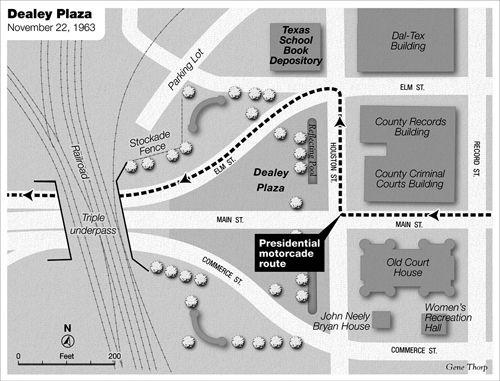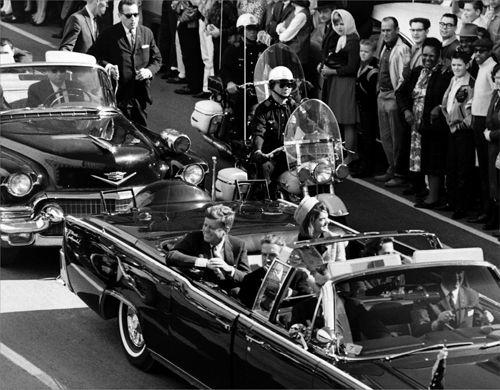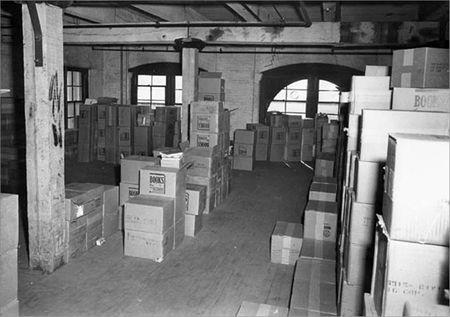Kennedy's Last Days: The Assassination That Defined a Generation (25 page)
Read Kennedy's Last Days: The Assassination That Defined a Generation Online
Authors: Bill O'Reilly


Crowds greet the presidential motorcade. The Secret Service ride in the car behind the president’s limousine.
[© Associated Press]
CHAPTER THIRTY-FOUR
NOVEMBER 22, 1963
Dallas, Texas Noon
I
T
’
S LUNCHTIME AT THE
Texas School Book Depository. Most of Lee Harvey Oswald’s coworkers have left the building, hoping to get a glimpse of the president, so the sixth floor is deserted.
Just down the block, FBI special agent James Hosty has forgotten all about investigating Lee Harvey Oswald and is just trying to make sure he gets a look at his hero, President Kennedy.
Lee Harvey Oswald didn’t bring a lunch to work today. And he doesn’t plan on eating. Instead, he gets into position at the window behind the boxes of books.

At 12:24
P.M.
, nearly 30 minutes into the motorcade, the president’s car passes Special Agent James Hosty on the corner of Main Street and Field. Hosty gets his wish and sees Kennedy in the flesh, before turning back around and walking into the Alamo Grill for lunch.
At 12:29
P.M.
, the motorcade makes the sharp right-hand turn onto Houston Street. From high above, in his sixth-floor sniper’s lair, Lee Harvey Oswald sees John F. Kennedy in person for the first time. He quickly sights his Italian carbine, taking aim through the scope as the motorcade skirts the edge of Dealey Plaza.
The crowds here are still large and enthusiastic, despite Chief Curry’s prediction that they would have thinned out by this point. The people shout for Jackie and the president to look their way. As they have agreed, JFK waves at the people standing in front of buildings on the right side of the road, while Jackie waves at those standing along grassy Dealey Plaza, to their left. This ensures that no voter goes without a wave.
The motorcade is just five minutes from the Trade Mart, where Kennedy will make his speech. Almost there.
Inside the presidential limousine, Nellie Connally stops waving long enough to look over her right shoulder and smile at John Kennedy. “Mr. President, you can’t say Dallas doesn’t love you.”

For most of the trip, Kennedy and Jackie shared smiles on their side of the road.
[© Bettmann/Corbis]
At that very moment, if JFK had looked up to the sixth floor of the Texas School Book Depository, he would have seen a rifle barrel sticking out of an open window, pointed directly at his head.
But Kennedy doesn’t look up.
Nor does the Secret Service.
It is 12:30
P.M
. The time has come for Special Agent Bill Greer to steer the limousine through the sweeping 120-degree left turn from Houston and onto Elm.
* * *
Lee Harvey Oswald leans hard against the left window and presses the butt of the Mannlicher-Carcano against his right shoulder. The scratched wooden stock of the gun rests against his cheek. His right index finger is curled around the trigger.
He peers into his telescopic sight. John Kennedy’s head looks as if it is two feet away. Oswald knows time is short. He’ll be able to shoot two shots for sure. Three if he’s quick. He probably has only nine seconds.
Seeing his target clearly, Oswald exhales, gently squeezes the trigger, and even as he feels the recoil kick the rifle hard against his shoulder, he smoothly pulls back the bolt to chamber another round. He can’t tell whether the first bullet has done much damage. But that doesn’t matter. Oswald must immediately fire again.
Because if the first shot somehow misses, just like that shot missed General Walker back in April, and the president lives, Oswald will look like a fool again. And that’s the last thing he wants. No, the plan is to kill John Fitzgerald Kennedy. And Lee Harvey Oswald will see that plan through.
He doesn’t think twice. Oswald fires again.
The sound of the second shot is so loud that pieces of the plaster ceiling inside the Texas School Book Depository fall and the panes of the windows Lee Harvey Oswald stands next to rattle.
Approximately 8.4 seconds after firing his first shot, Lee Harvey Oswald pulls the trigger a third time. And then Oswald bolts. He drops the gun, steps out from the tower of boxes, and runs down the stairs.
Upon hearing the first shot, Dallas motorcycle officer Marrion Baker raced into the building and up the stairs. He stops Oswald at gunpoint on the second floor but lets him go when it becomes clear that Oswald is an employee.
Sixty seconds later, the 24-year-old assassin walks out into the sunshine.

Photograph of the sixth floor of the Texas School Book Depository taken on November 22, 1963. Oswald stood at the window on the right, behind the stacks of boxes.
[NARA/JFK Assassination Records]
CHAPTER THIRTY-FIVE
NOVEMBER 22, 1963
Dallas, Texas 12:30
P.M.
E
ARWITNESS TESTIMONY IN
D
EALEY
P
LAZA
will later confirm that three shots were fired from the depository. One of the shots misses the president’s car completely, and decades later, people still wonder whether it was the first or third shot. But the fact remains that two of the shots did not miss.

People take cover after they hear gunshots.
[© Bettmann/Corbis]
The first impact strikes the president in the back of his lower neck. Traveling at 1,904 feet per second, the 6.5-millimeter round tears through the president’s trachea and then exits his body through the tight knot of his dark blue tie. No bones are struck, and though his right lung is bruised, JFK’s heart and lungs still function perfectly.
The president is badly hurt, but very much alive. He has trouble breathing and talking as blood floods into his windpipe. Otherwise, the rifle shot will most likely not kill him.
The same cannot be said for Texas governor John Connally. His jump seat, immediately in front of the president, is three inches lower than where the president is currently sitting. Ballistic studies performed later show that the bullet passed through Kennedy, then entered Connally’s back.
The governor had turned his body just before Oswald fired the shot. He was twisting around, trying to speak face-to-face with the president. The bullet pierces Connally’s skin and travels through his body, exiting below the right side of his chest. But it isn’t finished. It then pierces the governor’s wrist and deflects off the bones and into his left thigh, where it finally comes to rest.
The blow knocks Governor Connally forward, bending him double. His chest is immediately drenched in blood. “No, no, no, no,” he cries, “they’re going to kill us all.”
Roy Kellerman thinks he hears the president yell, “My God, I’m hit,” and turns to look over his left shoulder at the man whose Boston accent he knows so well.
Kellerman sees that JFK has been shot.
The torso of a normal man would have been shoved farther forward by the force of a bullet striking his body at nearly twice the speed of sound. This is precisely what happened to Governor Connally. If John F. Kennedy had been knocked forward, he might have lived a long life.

Clint Hill climbs onto the trunk of the presidential limousine.
[© Bettmann/Corbis]
But now the president’s painful struggle with back problems returns to torture him one last time. The back brace that he is wearing holds his body straight up. If not for the brace, the next bullet, fired less than five seconds later, would have traveled harmlessly over his head.
But it does not. The next bullet explodes his skull.
The diameter of the entry wound from the second impact is just slightly wider than that of a number two pencil. The bullet barely slows as it slices through the tender gray brain matter before exploding out of the front of his head. This bullet ends John F. Kennedy’s life in an instant.
